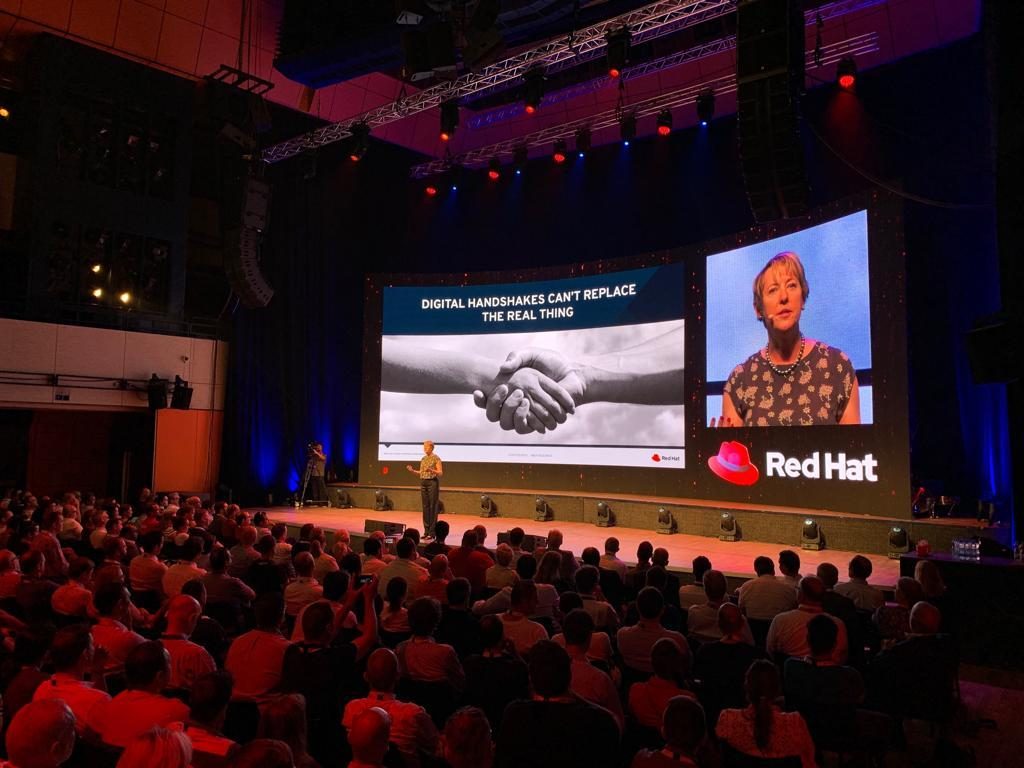Prague, June 2019. The auditorium is packed. And the spotlights are so bright, I can only see faces in the first couple of rows. I focus on a couple of smiling men in the front. I’m here to talk about digital transformation from a different perspective. I can tell the message is resonating: “we can’t focus on technology alone but need to think about the human connection in digital transformation.”
Even though I can’t see everyone, I feel their positive energy and their eyes on me. I hear their laughter. We have connected.
To be honest, I wasn’t sure it would work. This is a technology conference with hundreds of IT solution providers, managed services companies, and software vendors. But throughout the event, people stopped me and said “thank you for not talking about products and for sharing your thoughts on the human connection instead.”
This story is an evolution of the digital transformation journey that I’ve been discussing with customers for a couple of years. In talking to organizations all over the world, I learn first hand that technology decisions and architectural considerations are huge challenges. However, a bigger block to making the much needed transformation is people.

Margaret keynoting at the Red Hat Partner Conference in Prague.
If you missed Part 1 of my blog on Digital Transformation, I encourage you to pause and read it here. For those who read part one already, Let’s pick up our discussion with Human Connection number five:
5. Focus on the user experience
When I worked at Amazon in the early 2000’s, my office consisted of the standard door desk on 4 x 4’s, a chair, and a bookshelf. No standing desks or special ergonomic chairs. Employee ergonomics was not the focus; the customer experience was. In everything we did, employees were challenged to ask ourselves, “would this help the customer experience?” If the answer was no, then priorities were redirected.
This may be an extreme example. However, it’s not an accident that Amazon introduces so many user innovations. From its earliest days, Amazon led the e-commerce industry with user-focused capabilities and creating a human connection in a digital environment. Innovations such as predictive analytics, one-click buying, and personal recommendations that we take for granted today. Amazon maintained this discipline and market leadership when it introduced Amazon Web Services. AWS focuses on giving developers a fast, easy experience and access to the tools they need. Its focus on the user continues with its Alexa personal assistant service and Amazon Go, the futuristic supermarket where customers can grab products and leave without ever pulling out their wallet.
Unfortunately, many technology companies do the opposite of Amazon. They start with the cool technology and slap on the user experience as almost an afterthought. And then, when the product is not as successful as they hoped, engineers and product managers start adding more ease of use, point and click widgets, and help buttons.
The cost of poor user experience is high
The cost of not starting with user experience? According to CareerFoundry, who manage a Web UX design (user experience) school, the cost is high. Its research estimates that bad user experience costs e-commerce companies $1.4 trillion. Yes, trillion! For IT projects in general, the research estimates a loss of $150 billion due to abandoned projects.
As we focus on the human connection part of digital transformation, user experience takes the front seat and is a top priority. We start with the user. What are they trying to do? What is the pain we are hopefully solving?
This is no different than the best practices around Web UX design. The goal is to deliver the content a user is seeking with the fewest number of clicks. More than two clicks or 10 seconds, and the user aborts its search on your site.
Modern UX is moving beyond traditional interfaces to incorporate artificial intelligence, giving users the feeling they are interfacing with a human being rather than a digital thing. One of these AI movements is called “Conversational Design”, where products and websites incorporate the way humans talk to each other. With this, UX becomes more personal and personalized.
6. Create cross-organizational teams and processes
Teamwork is an overused term. The reality is that few organizations either inspire or reward true teamwork across departments or even within a division. However, digital transformation requires collaboration and a shared vision of success across and within teams.
In fact, this closer collaboration is not just nice to have. Your employees want to have better connections and teamwork with their colleagues. The Slack Future of Work Study found that team relationships and connections are vital to transformational success. According to the research, 91% of workers want to feel closer to their work colleagues, and 85% of workers want to feel more connected with their remote colleagues.
Reach out to other teams to break down silos
For any project or initiative, it’s easy to invite the same people to help. But why not reach out across the organization and include people who you rarely or never work with?
Let’s say you are a bank, and your team is charged with building a new application to enable customers to take digital photos of checks and deposit them via this mobile app. You will immediately bring together your business team colleagues and your developers. But how about also inviting a couple tellers from one of your bank branches, an IT Operations colleague from the data center, someone from legal, a data scientist and a data privacy expert. You get the idea.
I believe vendors and partners can help broker these cross-silo initiatives and conversations. As an outsider, you are often able to see and work with different parts of an organization that people within the company don’t know. Use these relationships to help drive closer teamwork. The benefit for you is more business and more successful projects.
Some vendors have services designed to do this, such as Red Hat’s Open Innovation Labs. Using DevOps and Agile processes, the labs residency program brings together business, technical and other people from across an organization to solve a specific problem or kick off a major project.
7. Reward people and teams who take risks
Change is scary, and one big reason is because it requires taking risks, and potentially, failing. Digital leaders encourage a fail fast culture, where individuals and teams are not just encouraged to take risks, but are rewarded for doing so.
According to McKinsey’s research, respondents at successful digital organizations are more than twice as likely as their peers elsewhere to strongly agree that employees are rewarded for taking risks. And they are nearly three times likelier to say their organizations reward employees for generating new ideas.
Digital disruption does not happen by standing still or encouraging small moves. It takes big bets. This means leadership must also be willing to stand up for employees who try new ideas and push the boundaries. Digital leaders go “all in” on the transformation, because taking risks is less riskier than doing nothing or making incremental changes.
It all goes back to culture. You can’t take the risks needed to disrupt and transform unless yo’uve created a culture that makes it safe to do so. But how do we create or promote a culture of smart risk taking?
Gordon Tredgold, the Founder and CEO of Leadership Principles, suggests there are 5 ways to encourage smart risk taking:
- Model risk taking behavior
- Define smart risks and set limits
- Create a safe environment for taking risks
- Identify your best risk takers and unleash them
- Reward smart failures

8. Develop your people for the future
In the research I conducted in 2018, we found that the lack of skill set and training were the top blockers to achieving digital transformation. Technology and digital processes are changing so quickly, it’s hard to keep up. This is creating a digital skills gap in organizations across industries and around the world.
The cost of this gap is high. Not just to companies but to entire economies.
Accenture estimates the digital skills gap could cost the United Kingdom £141 billion in GDP (Gross Domestic Product) growth. For all the G20 countries combined, the risk of not filling the digital skills gap could cost more than US$11.5 trillion in GDP growth over the next ten years.
Rather than hoping to hire people with the skills and talent you need, I encourage organizations to develop the people you have. Take your loyal employees who already fit your culture and believe in your vision and invest in them. If you don’t have an internal training organization, work with partners and vendors to deliver the training required.
There are both hard and soft skills needed for digital transformation. For example, you may need to help your existing IT staff or developers learn new programming languages and tools. Your existing analytics team may need training on the latest data science technologies and processes.
On the soft skills side, it’s important to provide managers with new ways to empower their teams, manage risk, and lead with transparency. Everyone may need to learn more agile and collaborative ways of working together.
Diversity & Inclusion Helps with Skills Gap
In addition to teaching next-generation skills, it’s important to enable everyone to participate in the digital transformation. This means improving your diversity and inclusion. D&I is no longer just the right thing to do for humanity. It also is proven to have a direct positive business impact and financial return.
For example, inclusive and diverse teams are often smarter, faster and more productive, according to research conducted by Forbes and Cloverpop. The research found inclusive teams make better business decisions 87% of the time, and deliver better results 60% of the time. In addition, these diverse teams are twice as fast to make decisions with half as many meetings required to do so.
The Center for Talent Innovation, which drives ground-breaking research on talent and its impact, validates these findings. “Diversity and inclusion must go hand-in-hand to drive business results,” says Laura Sherbin, the center’s CFO and director of research.
Human Connection for Double Bottom-Line Results
Technology is still needed for a successful digital transformation. However, technology must be combined with human connection. In other words, it’s not just the “what” you use to transform, but the “how” and the “why” of your transformation. The human elements require hard work across your culture, your hiring, your people development, your leadership, and your communication.
Alan Gershenfeld, the founder and president of E-Line Media and one of the authors of Designing Reality, has coined the phrase: “Double Bottom-Line Company.” This defines an organization that is committed to both positive financial returns AND meaning social impact.
I want to believe that the future of capitalism supports this idea of making money and changing the world, for the better.
Why can’t we all strive to be double-bottom-line companies? This is the ultimate human connection to our digital transformation.
Note: This is the final post in a 3 part series on The Human Factors in Digital Transformation, by Margaret Dawson. Read part 1 here, and part 2 here. Please comment, share, and follow @snortoutloud and @seattledawson on Twitter and Instagram. Interested in guest blogging for SNOL? We’d love to hear from you. Please contact us with your suggested topic.


